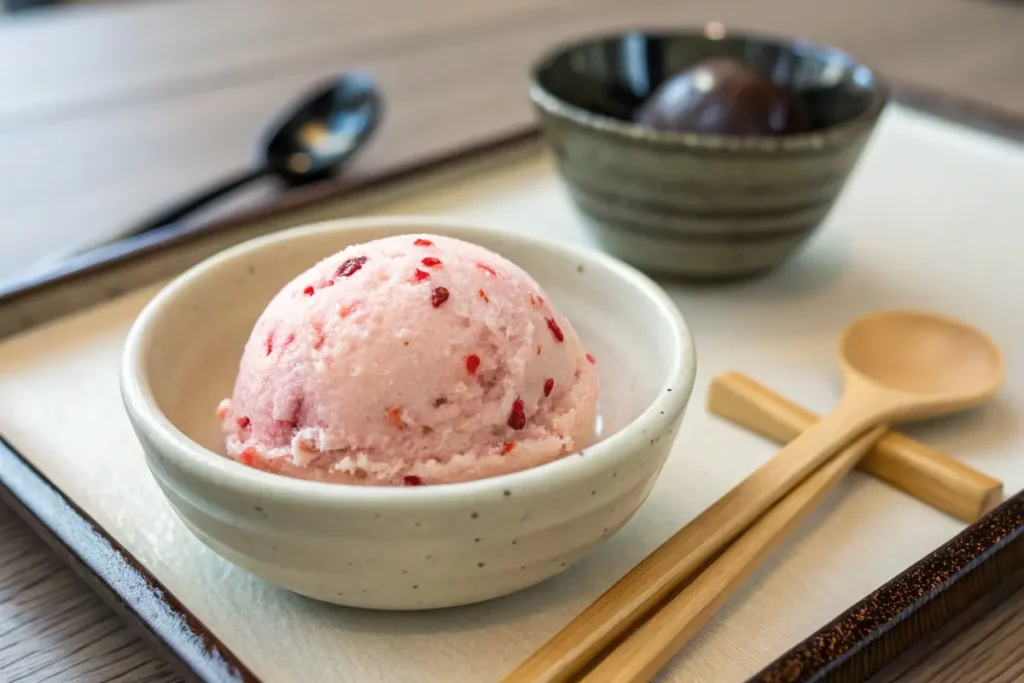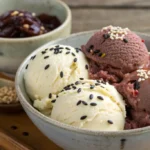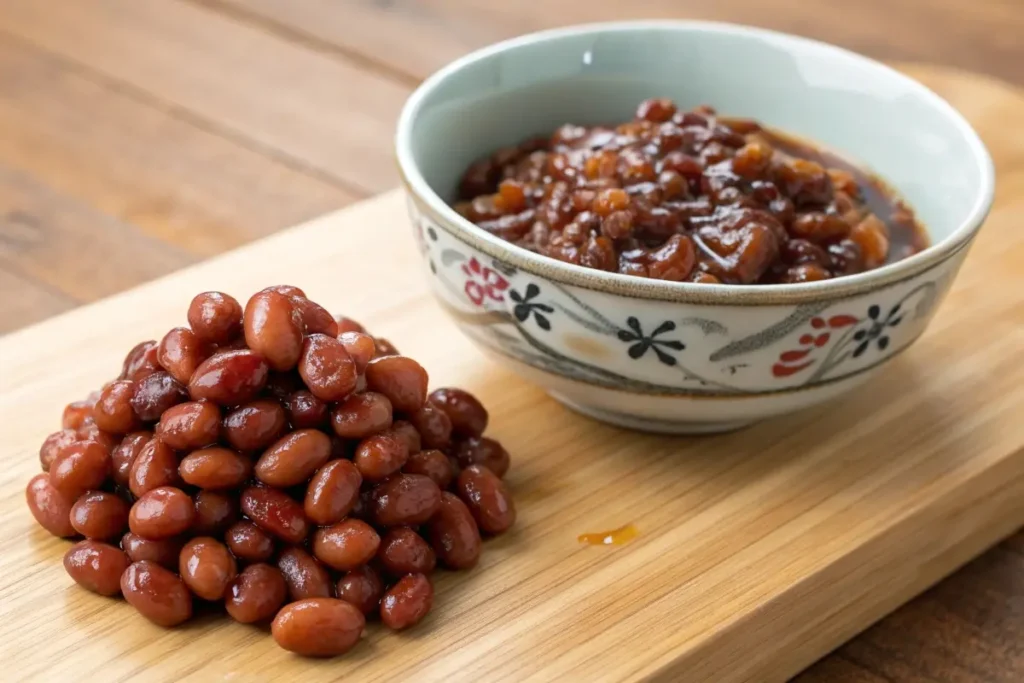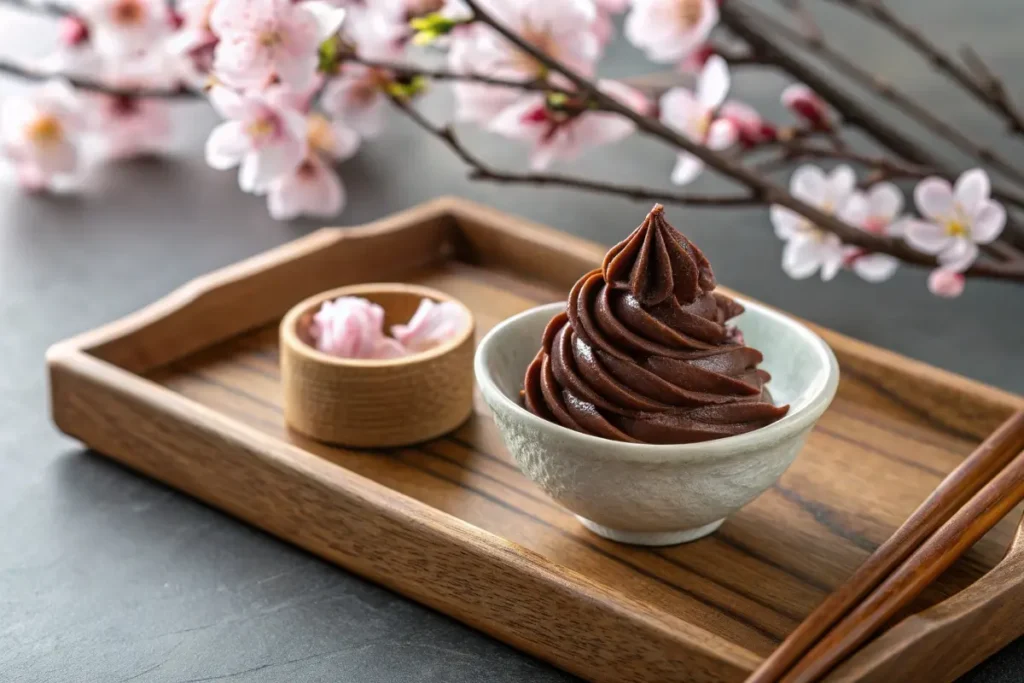
Few desserts captivate the senses quite like azuki red bean ice cream, a Japanese specialty that merges creamy texture with the gentle sweetness of azuki beans. Within the first scoop, you’ll discover a harmonious blend of earthy notes and subtle sugars—a testament to why azuki red bean ice cream has become a beloved treat across Asia and beyond. In recent years, it’s gained a global following, enticing ice cream enthusiasts with its unique flavor profile and nutritious charm. Whether you’re a die-hard fan of traditional mochi ice creams or an adventurous eater ready to try something new, this guide covers everything you need to know about making, enjoying, and even experimenting with azuki red bean ice cream at home.
Explore more Japanese desserts here to expand your sweet repertoire after you’ve mastered this red-bean-infused delight. By the end of this article, you’ll be well-versed in the cultural background, culinary techniques, and health considerations of azuki red bean ice cream, ready to whip up your own batch or order with confidence at your nearest Asian eatery.
Print
Azuki Red Bean Ice Cream: A Complete Guide to Japan’s Beloved Sweet Treat
- Total Time: 10 minutes prep + chilling
- Yield: about 3 cups
- Diet: Vegetarian
Description
Azuki Red Bean Ice Cream – a traditional Japanese frozen dessert using sweet azuki bean paste, milk, and sugar; subtly nutty, lightly sweet, and best served chilled, often garnished with toasted black sesame or a drizzle of condensed milk.
Ingredients
1¼ cups whole milk
⅓ cup sugar (adjust to taste)
15 oz sweet red bean paste (anko)
Optional: 2 tsp toasted black sesame seeds or condensed milk for topping
Instructions
1. Combine milk and sugar in a saucepan over medium heat until sugar dissolves.
2. Stir in red bean paste (anko) and heat until well blended (do not boil).
3. Let the mixture cool, then chill thoroughly in refrigerator.
4. Churn in ice cream maker according to manufacturer’s instructions (approx 20 min).
5. Transfer to container and freeze 4–6 hours or until firm.
6. Serve chilled, sprinkled with toasted sesame or drizzled with condensed milk if desired.
Notes
Authentic texture uses smooth paste; tsubu‑anko (chunky) gives more bean texture.
Japanese style is firmer and less creamy, without heavy cream or eggs :contentReference[oaicite:6]{index=6}.
Leftover ice cream may become very hard—let sit a few minutes before scooping for best texture :contentReference[oaicite:7]{index=7}.
- Prep Time: 5
- Cook Time: 5
- Category: Dessert
- Method: Stove‑top cooking + ice cream maker
- Cuisine: Japanese
Nutrition
- Serving Size: ½ cup
- Calories: 120
- Sugar: 20g
- Sodium: 10mg
- Fat: 5g
- Saturated Fat: 3g
- Unsaturated Fat: 2g
- Trans Fat: 0g
- Carbohydrates: 25g
- Fiber: 1g
- Protein: 3g
- Cholesterol: 20mg
Keywords: azuki red bean ice cream recipe, Japanese dessert, anko ice cream
Table of Contents
Understanding the Azuki Red Bean
Azuki beans—sometimes spelled adzuki—are small, reddish-brown legumes commonly used in East Asian cuisine, particularly in Japan, China, and Korea. They have a slightly sweet taste, a smooth texture when boiled, and a high protein and fiber content. In Japanese cooking, these beans often find their way into desserts, most famously as anko—a sweet red bean paste employed in everything from mochi to dorayaki pancakes.
What Flavour is Azuki Red Bean?
If you’ve never tried azuki beans, imagine a gentle sweetness without the sugary intensity of regular candy. Their flavor includes faint nutty notes and a mild earthiness that many describe as comforting and satisfying. It’s neither overly strong nor bland, offering just enough sweetness to complement rich ingredients like cream, sugar, and milk in ice cream.
Why Azuki Beans Are Perfect for Ice Cream
- Textural Contrast: Cooked azuki beans, or sweet red bean paste, create a delightful interplay of textures in ice cream. You get pockets of bean bits or swirls of paste in the creamy base.
- Flavor Synergy: The milky base softens the earthy tones of azuki beans, resulting in a pleasantly light sweetness.
- Cultural Roots: Red bean desserts are a staple in Japanese and other East Asian cuisines, providing a sense of nostalgia for those who grew up with them.
Azuki vs. Other Legumes
Unlike black beans or chickpeas, azuki beans contain less starch and a more subtle flavor, making them easier to incorporate into sweet recipes. Their distinctive red color also yields a lovely pinkish hue in desserts, which is part of the aesthetic appeal of azuki red bean ice cream.
Forms Used in Ice Cream
- Whole Beans: Gently boiled, sweetened, and mixed into the ice cream base for added texture.
- Smooth Paste (Anko): Blended thoroughly, creating a uniform swirl or integrated flavor throughout the dessert.
- Combination: A swirl of sweet bean paste plus scattered whole or partial beans, resulting in a multi-dimensional taste experience.
Appreciating the azuki bean is the first step in mastering azuki red bean ice cream. In the next section, we’ll delve deeper into the main ingredients, step-by-step processes, and variations that make this sweet treat so mesmerizing.

Internal Link Tip: For more Japanese sweets featuring azuki beans, see our Traditional Japanese Desserts Recipe to discover a variety of bean-based confections.
Crafting the Perfect Azuki Red Bean Ice Cream
Essential Ingredients
To create azuki red bean ice cream, you’ll need a handful of basic ingredients:
- Heavy Cream and Milk: Form the creamy backbone of the dessert.
- Sugar or Sweetener: Balances the legume’s subtle earthy flavor.
- Cooked Azuki Beans or Paste: The star ingredient, providing color and distinctive sweetness.
- Optional Thickeners: Some recipes call for cornstarch or egg yolks for a more custard-like base.
You can also opt for a korean red bean ice cream style, which may include condensed milk to yield a denser, sweeter result. Alternatively, skipping dairy entirely and using coconut milk or almond milk can produce a vegan version.
Step-by-Step Preparation
- Cook the Beans (if using whole beans)
- Soak azuki beans overnight, then boil until soft. Drain and sweeten with sugar or a sweetener like honey. Let them cool before using.
- Make the Ice Cream Base
- Combine cream, milk, and sugar in a saucepan. Gently heat, stirring until the sugar dissolves. For an even richer texture, whisk in egg yolks (tempering carefully) or add a tablespoon of cornstarch mixed with cold milk.
- Add Azuki
- If using smooth paste, stir it directly into the warm base. For textured bits, swirl in the beans near the end of the churning process. This step ensures a balanced distribution of sweet red bean flavor.
- Chill and Churn
- Cool the mixture in the refrigerator for several hours or overnight to develop flavor. Then pour into an ice cream maker, following the manufacturer’s instructions.
- Freeze to Set
- Transfer the churned ice cream to a freezer-safe container. Freeze for at least 4-5 hours, until it reaches a scoopable consistency.
Pro Tips
- Slow Infusion: For a deeper flavor, consider simmering the cooked beans in the cream mixture. This approach allows more bean essence to permeate the base.
- Sugar Levels: Adjust sweeteners to your taste. Azuki beans have their own sweetness, so you might want less refined sugar.
- Texture Contrast: For a fun twist, add mochi bits or swirl in sweetened condensed milk for pockets of intense sweetness.
Cooking Equipment
- Ice Cream Maker: Ideal for a smooth, churned result.
- Hand Mixer or Blender: Useful for breaking down lumps if you prefer a fully integrated paste.
- No-Churn Method: Combine whipped cream, sweetened condensed milk, and bean paste. Fold gently, then freeze. The texture won’t be exactly the same, but it’s a simpler approach if you lack an ice cream maker.
Once you’ve mastered the basics, the possibilities are endless. Add a swirl of matcha for a green-tea-and-azuki fusion or garnish with fresh fruit for a refreshing contrast. Azuki red bean ice cream can be as versatile as your imagination allows.

Internal Link Tip: If you enjoy combining sweet flavors with hearty ingredients, you might also like our Mashed Japanese Sweet Potato Recipe, which offers a similarly comforting richness.
Taste, Texture, and Serving Suggestions
What Does Red Bean Ice Cream Taste Like?
While azuki red bean ice cream is often compared to flavors like vanilla or mild chocolate, it offers something distinctly different. The beans lend a subtle sweetness reminiscent of chestnuts, with an almost floral undertone. The red bean ice cream taste is not overpoweringly sweet, making it an ideal choice for those seeking a dessert that’s both indulgent and nuanced.
Texture Highlights
- Creamy Base: Traditional versions emphasize a velvety, custard-like consistency.
- Bean Bits: Occasional bean chunks or a swirl of sweet red bean paste add a chewy or grainy texture that delights the palate.
- Mochi Add-Ons: Some variations incorporate mochi pieces, bridging that gap between ice cream and a classic Japanese sweet.
Serving Suggestions
- Single Scoop Simplicity: Present a scoop in a small bowl or teacup with a minimal garnish, such as a mint leaf or drizzle of condensed milk.
- Waffle Cones or Taiyaki Cones: A fun approach is to serve red bean ice cream in fish-shaped taiyaki cones, echoing popular Japanese street-food aesthetics.
- Dessert Parfait: Layer with matcha jelly, fresh fruit, or whipped cream for a colorful treat.
- Mochi Topping: Adorn the ice cream with mini mochi cubes or soft mochi balls, enhancing the texture contrast.
Pairing with Other Foods
- Green Tea or Matcha: The robust, earthy bitterness of matcha complements the gentle sweetness of red bean.
- Grilled Fruits: Adding grilled pineapple or peaches can amplify the dessert’s natural sweetness.
- Western Desserts: You can incorporate azuki red bean ice cream into brownies or cookie sandwiches for a fusion flair.
Customizable Flavors
If you’re an experimental cook, consider spicing up your ice cream with:
- Cinnamon or Cardamom: Subtle spices can bring out the bean’s nuttiness.
- Chocolate Chips: Contrasting bitterness intensifies the sweet bean essence.
- Coffee Drizzle: The bitterness of coffee can introduce a sophisticated spin.
Ultimately, azuki red bean ice cream delivers a refined sweetness that sits between indulgent and subdued. Whether enjoyed on its own, accompanied by mochi, or served in a meticulously layered parfait, it invites you to experience a refreshing shift from conventional ice cream flavors.
Internal Link Tip: For more on combining sweet and savory in Japanese cuisine, check out our Japanese Curry Recipe One Piece, which demonstrates how subtle sweetness can elevate main dishes too.
Health Benefits and Nutritional Considerations
Is Azuki Red Bean Healthy?
The question “Is azuki red bean healthy?” often arises, and the short answer is yes—azuki beans can be a wholesome ingredient. While they do contribute natural sugars (especially after being sweetened for desserts), they also come packed with nutrients:
- Protein and Fiber: Azuki beans boast more protein and fiber than most common sweeteners, helping balance blood sugar spikes.
- Micronutrients: Rich in vitamins like B1 and minerals such as iron and magnesium, azuki beans support various bodily functions.
- Low Fat: Raw azuki beans are low in fat. Even though ice cream incorporates fats from dairy, the beans themselves don’t significantly raise fat content.
Nutritional Profile of Red Bean Ice Cream
Standard ice cream recipes can be high in saturated fats and sugar. When you add azuki red bean:
- Fiber Boost: The beans up the fiber content, aiding digestion and imparting a feeling of fullness.
- Antioxidants: Red beans contain anthocyanins, the same type of beneficial compounds found in berries.
- Moderate Sugar: Depending on your recipe, the overall sugar content might be lower than conventional ice creams, since the natural bean sweetness often allows you to reduce added sugars.
However, like all treats, azuki red bean ice cream should be consumed in moderation. The presence of cream, condensed milk, or sugar can still lead to a calorie-rich dessert.
Is Red Bean Ice Cream Healthy?
While no ice cream is a “health food,” you can adopt strategies to make red bean ice cream more nutritious:
- Use Lower-Fat Dairy: Swap out heavy cream for low-fat milk or coconut milk.
- Natural Sweeteners: Consider honey, maple syrup, or stevia.
- Fewer Add-Ins: Resist loading it with chocolate chips or caramel swirls if you aim for a lighter dessert.
Vegan and Dairy-Free Options
For those seeking dairy-free or vegan alternatives, azuki red bean mochi ice cream is a popular choice, substituting coconut cream or almond milk for traditional dairy. This approach preserves the essence of azuki beans while catering to dietary restrictions.
Portion Control and Serving Frequency
Even if your dessert is made with wholesome ingredients, it’s wise to keep portion sizes modest. A single scoop can be deeply satisfying without derailing balanced eating habits.
Additional Health Tips
- Pair with Fruit: Serve your ice cream with fresh berries or sliced peaches for added vitamins.
- Focus on Quality: Home-cooked versions let you control sweeteners and dairy sources, ensuring you skip artificial additives.
- Protein Pairings: If you’re concerned about blood sugar, enjoy your ice cream after a protein-rich meal to reduce glucose spikes.
By making mindful ingredient choices and applying portion control, azuki red bean ice cream can fit comfortably within a balanced diet—allowing you to savor its sweet, earthy goodness without guilt.

Internal Link Tip: For more light yet satisfying Japanese meal inspirations, explore our Healthy Japanese Recipes that integrate wholesome ingredients without sacrificing flavor.
Exploring Variations and Global Popularity
Regional Twists on Red Bean Ice Cream
While azuki red bean ice cream is primarily linked to Japanese cuisine, you’ll find other Asian cultures have developed their own approaches:
- Korean Red Bean Ice Cream: Known as patbingsu when served with shaved ice, condensed milk, and fruit toppings. The concept occasionally extends to a denser ice cream form, emphasizing intense sweetness.
- Chinese Red Bean Desserts: Mainland China and Hong Kong incorporate red beans in dessert soups and pastries. Ice cream stands as a natural progression, delivering a chilled twist on a classic.
- Taiwanese Shaved Ice: In Taiwan, shaved ice with sweet red bean toppings is ubiquitous. Melding these elements into an ice cream base is a popular extension.
Fusion Flavors Around the World
The gentle flavor of azuki can pair with numerous global tastes. Creative chefs have introduced:
- Matcha-Red Bean Swirl: Combining two iconic Japanese flavors into one swirling, visually striking dessert.
- Chocolate or Caramel: Adding a swirl of chocolate fudge or salted caramel to highlight the bean’s earthy sweetness.
- Fruit Mix-Ins: Incorporating lychees or strawberries for extra bursts of fruity tang.
Red Bean Mochi Ice Cream
No conversation about red bean ice cream is complete without mentioning mochi ice cream. Encased in a soft, sticky rice dough, red bean mochi ice cream merges the elasticity of mochi with the creaminess of azuki red bean ice cream. The result is a bite-sized treat that’s easy to serve at parties or keep as a freezer staple.
Growing Global Popularity
As Japanese desserts continue to captivate international audiences, more specialty stores, Asian grocery chains, and even mainstream supermarkets offer variations of red bean ice cream. Western ice cream brands sometimes roll out limited-time flavors featuring azuki beans. Meanwhile, dessert shops experiment with sundaes, soft-serve versions, or even ice cream sandwiches using unique pastry shells.
Culinary Adventures
You can incorporate azuki red bean ice cream in adventurous ways:
- Ice Cream Cakes: Layer it with sponge cake or alternate with green tea ice cream for a color contrast.
- Dessert Bars: Freeze the mixture in popsicle molds with layered sweet bean paste.
- Savory Pairings: A subtle, sweet dessert can follow a spicy or heavily savory meal, particularly in fusion restaurants bridging Eastern and Western gastronomic trends.
With each spin on classic red bean ice cream, the universal thread remains: a balanced interplay of sweetness and earthy depth. Whether you’re enjoying a simple scoop at home or indulging in a gourmet fusion dessert abroad, azuki red bean ice cream transcends cultural boundaries, standing as a testament to the versatility of humble legumes.
Internal Link Tip: Looking for more dessert fusion ideas? Browse our Japanese Cookies for pairing possibilities that blend traditional and modern tastes.
History and Examples
History/Context
The journey of azuki red bean ice cream is deeply intertwined with the broader story of azuki beans in East Asia. Historical records show that these beans have been cultivated and consumed for over a thousand years in China and Japan. Their sweet, easy-to-digest properties made them a staple for religious offerings and temple cuisine.
From Temple Sweets to Modern Confections
In Japan, azuki beans transformed from humble temple fare to mainstream sweeteners around the Edo period (1603–1867). As sugar became more affordable, sweet bean pastes emerged in popular confections like manju (steamed buns) and dorayaki (pancakes). Over time, chefs began experimenting with chilled desserts. The early 20th century, with the introduction of refrigeration technology, paved the way for ice cream in Japan. Innovative parlors in Tokyo and Osaka started blending local flavors—matcha, black sesame, and, of course, azuki bean—into Western-style ice creams.
Influence of International Food Culture
During the post-World War II era, American-style ice cream shops gained traction in urban Japan. However, local palates craved more familiar flavors, prompting a wave of domestically inspired ice creams. Azuki’s natural sweetness and nostalgic resonance made it a prime candidate. By the 1970s and 1980s, large-scale manufacturers in Japan were offering prepackaged azuki red bean ice cream, solidifying its status as a common supermarket find.
Global Spread
In the late 20th and early 21st century, Japanese culinary trends—like sushi, ramen, and mochi—swept across North America and Europe. Alongside these imports, red bean desserts quietly gained niche popularity. Cafés and dessert bars in Western cities started featuring red bean ice cream or mochi ice cream as exotic, yet approachable, menu items. Social media later amplified this interest, with food bloggers showcasing the dessert’s pretty pink hue and subtle flavor. Today, you’ll find azuki red bean ice cream not just in Asian supermarkets but in artisan ice cream parlors that celebrate global flavors.
Practical Examples/Use Cases
1. High-End Dessert Menus
Fancy restaurants in Tokyo and Kyoto often feature homemade azuki red bean ice cream accompanied by delicate garnishes—like edible gold flakes, artisanal wagashi sweets, or a drizzle of green tea syrup. The dessert offers a cultural tie-in for diners seeking an authentic taste of Japan’s sweet traditions.
2. DIY Parfait at Home
For a family-friendly treat, layer crushed biscuits or cornflakes at the bottom of a glass, add a scoop of azuki red bean ice cream, drizzle chocolate sauce or condensed milk, and top it off with sliced strawberries or bananas. This quick hack merges Western parfait style with an Eastern twist.
3. Summer Festivals
In Japan, summer festivals or matsuri often sell shaved ice with sweet red bean toppings. Some stalls upgrade this concept to a scoop of red bean ice cream served on top of shaved ice, offering an extra-chilled delight that combats the heat.
4. Ice Cream Mochi Shops
Modern dessert shops sometimes showcase red bean mochi ice cream, wrapping the sweet bean-infused ice cream with thin mochi dough. Each piece is portion-controlled, making it easy to sample multiple flavors in one sitting.
Such real-life scenarios underscore the dessert’s adaptability—from refined fine-dining experiences to casual family suppers. Whether you’re savoring a single scoop or diving into a parfait brimming with toppings, azuki red bean ice cream bridges culture and taste in sweet harmony.
FAQs about Azuki Red Bean Ice Cream
Below are some frequently asked questions about azuki red bean ice cream, offering quick insights to dispel common curiosities.
1. What Flavour is azuki red bean?
Azuki beans have a mildly sweet, nutty, and almost earthy flavor. When sweetened and cooked, they develop a smooth, rich taste. Blending them into ice cream amplifies their subtle sweetness, creating a balanced dessert that’s not as sugary as typical Western-style flavors.
2. What does red bean ice cream taste like?
Compared to traditional vanilla or chocolate, red bean ice cream is gentler. It carries notes of sweetness, a hint of earthiness, and sometimes a soft grainy texture if whole beans are included. This combination can be surprisingly refreshing, especially if you’re used to heavier, sugar-laden ice creams.
3. Is azuki red bean healthy?
Azuki beans are known for their protein, fiber, and antioxidant content. They’re relatively low in fat (before being sweetened). When incorporated into desserts, they still provide beneficial nutrients—although sweetness is usually added in the form of sugar or syrup. Moderation remains key for a balanced diet.
4. Is red bean ice cream healthy?
Any ice cream, including red bean ice cream, contains added sugars and fats. However, thanks to the bean-based component, you get added fiber and micronutrients absent in standard ice cream flavors. You can opt for reduced sugar or dairy-free variations to make it lighter. The healthiest route is mindful portion sizes and possibly making it at home with controlled ingredients.
5. Can I make red bean ice cream without an ice cream maker?
Yes. No-churn methods involve whipping cream (or a non-dairy alternative) and folding in sweetened condensed milk plus azuki paste. It won’t match the ultra-smooth texture of churned ice cream, but it’s still creamy and delicious.
Feel free to tailor your ingredients, cooking methods, or portion sizes to match your dietary needs or taste preferences. The best part of azuki red bean ice cream is its versatility—whether you want it decadent or lightly sweet, it’s an easily adaptable dessert.
Conclusion
Azuki red bean ice cream merges the comforting sweetness of beans with the rich creaminess of a classic frozen treat. Its understated flavor appeals to both traditionalists and dessert adventurers, making it a mainstay in Japanese ice cream shops and an emerging favorite internationally. Beyond mere novelty, azuki red bean ice cream offers a dose of protein, fiber, and antioxidants—adding a hint of nutritional value to your indulgence.
By exploring variations, from the simple homemade scoop to complex parfaits or mochi-stuffed bites, you can appreciate the dessert’s adaptability and cultural significance. Whether you’re enticed by the traditional methods or eager to experiment with vegan or fusion twists, azuki bean ice cream remains a dessert that both honors Japanese heritage and embraces global culinary innovation.
Discover even more Japanese dessert possibilities to expand your sweet repertoire. From red bean pancakes to mochi-based delights, the world of Japanese confectionery is vast and ever-inspiring. So go ahead—whip up your own batch of azuki red bean ice cream, share it with friends, and relish in its subtle, earthy charm that sets it apart from everyday frozen treats.

